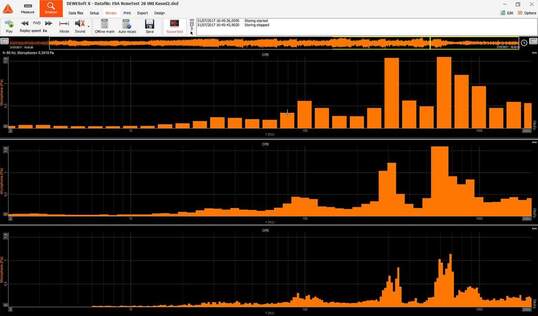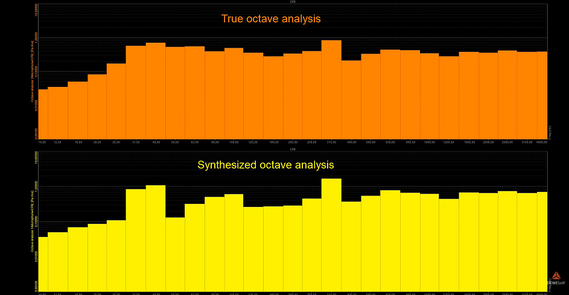Octave Analysis for Predictive Maintenance & Monitoring
Octave analysis is an indispensable tool for sound measurement as well as predictive maintenance and monitoring due to its logarithmic frequency axis.
Dewesoft octave analysis solution meets all of the IEC and ANSI Class 1 specifications for octave filters.
Octave analysis is an indispensable tool for sound measurement as well as predictive maintenance and monitoring due to its logarithmic frequency axis.
Dewesoft octave analysis solution meets all of the IEC and ANSI Class 1 specifications for octave filters.
Constant Percentage Bandwidth (CPB)
CPB filter is a filter whose bandwidth is a fixed percentage of a centre frequency. The width of the individual filters is defined relatively to their position in the range of interest. The higher the centre frequency of the filter, the wider the bandwidth.
The widest octave filter used has a bandwidth of 1 octave. Many subdivisions into smaller bandwidths are often used. The filters are often labeled as "Constant Percentage Bandwidth" filters. A 1/1-octave filter has a bandwidth of close to 70 % of its centre frequency. The most popular filters are perhaps those with 1/3-octave bandwidths. One advantage is that the bandwidth at frequencies above 500 Hz corresponds well to the frequency selectivity of the human auditory system. Dewesoft supports up to 1/24-octave bandwidth.
CPB filter is a filter whose bandwidth is a fixed percentage of a centre frequency. The width of the individual filters is defined relatively to their position in the range of interest. The higher the centre frequency of the filter, the wider the bandwidth.
The widest octave filter used has a bandwidth of 1 octave. Many subdivisions into smaller bandwidths are often used. The filters are often labeled as "Constant Percentage Bandwidth" filters. A 1/1-octave filter has a bandwidth of close to 70 % of its centre frequency. The most popular filters are perhaps those with 1/3-octave bandwidths. One advantage is that the bandwidth at frequencies above 500 Hz corresponds well to the frequency selectivity of the human auditory system. Dewesoft supports up to 1/24-octave bandwidth.
CPB Calculation Principle
Dewesoft Octave instrument is meant to display the frequency components of acquired signals in amplitude and frequency. The octave analysis is synthesized from the FFT analysis. The octave visual display can display only one channel at a time.
To keep an overview of the octave, Dewesoft can calculate the RMS values displayed signals. To activate the calculation, just click on the RMS button to see the RMS values.
True Octave (ANSI, IEC)
Uses filter sets as in analog octave analyzers. One of the main advantages is that we can really see the dynamic behavior of the input data.
Synthesized
Calculated using FFT analysis as the base and is updated when every FFT is being calculated.
Dewesoft Octave instrument is meant to display the frequency components of acquired signals in amplitude and frequency. The octave analysis is synthesized from the FFT analysis. The octave visual display can display only one channel at a time.
To keep an overview of the octave, Dewesoft can calculate the RMS values displayed signals. To activate the calculation, just click on the RMS button to see the RMS values.
True Octave (ANSI, IEC)
Uses filter sets as in analog octave analyzers. One of the main advantages is that we can really see the dynamic behavior of the input data.
Synthesized
Calculated using FFT analysis as the base and is updated when every FFT is being calculated.
Frequency Weighting
Frequency weighted noise measurements offer standard ways to measure sound, and we use each of these frequency weightings for different types of measurements.
A-weighting is applied to measured sound levels in an effort to account for the relative loudness perceived by the human ear. The human ear is less sensitive to low and high audio frequencies.
B-weighting is the best weighting to use for music listening purposes.
C-weighting is used for high-level noise measurements.
D-weighting was specifically designed for use when measuring high-level aircraft noise in accordance with the IEC 537 measurement standard. The large peak in the D-weighting curve reflects the fact that humans hear random noise differently from pure tones, an effect that is particularly pronounced around 6 kHz.
Z-weighting is linear at all frequencies and it has the same effect on all measured values.
Frequency weighted noise measurements offer standard ways to measure sound, and we use each of these frequency weightings for different types of measurements.
A-weighting is applied to measured sound levels in an effort to account for the relative loudness perceived by the human ear. The human ear is less sensitive to low and high audio frequencies.
B-weighting is the best weighting to use for music listening purposes.
C-weighting is used for high-level noise measurements.
D-weighting was specifically designed for use when measuring high-level aircraft noise in accordance with the IEC 537 measurement standard. The large peak in the D-weighting curve reflects the fact that humans hear random noise differently from pure tones, an effect that is particularly pronounced around 6 kHz.
Z-weighting is linear at all frequencies and it has the same effect on all measured values.
Averaging Type
Averaging is used to get more stable results in the octave display. There are three averaging modes available:
Linear Averaging: Each FFT counts the same
Exponential Averaging: FFT's become less and less important with time
Peak Hold Averaging: Only maximum results are stored and shown
Averaging is used to get more stable results in the octave display. There are three averaging modes available:
Linear Averaging: Each FFT counts the same
Exponential Averaging: FFT's become less and less important with time
Peak Hold Averaging: Only maximum results are stored and shown
Octave Band Display & Visualization
Dewesoft supports two different octave display types which can be selected and changed in real-time according to your application:
Bar Band Display Type
Line Band Display Type
The octave display offers all important information visualized like:
channel name / unit / frequency information / calculated values
Dewesoft supports two different octave display types which can be selected and changed in real-time according to your application:
Bar Band Display Type
Line Band Display Type
The octave display offers all important information visualized like:
channel name / unit / frequency information / calculated values






